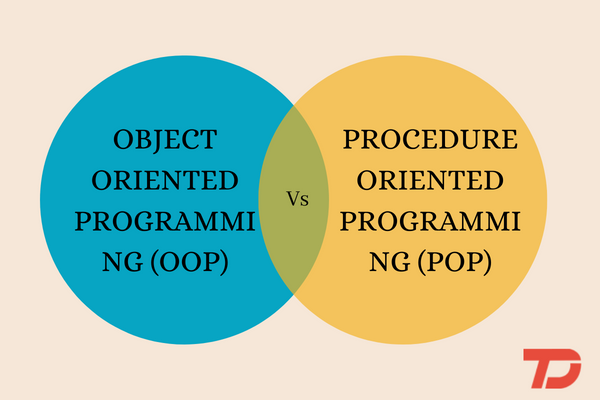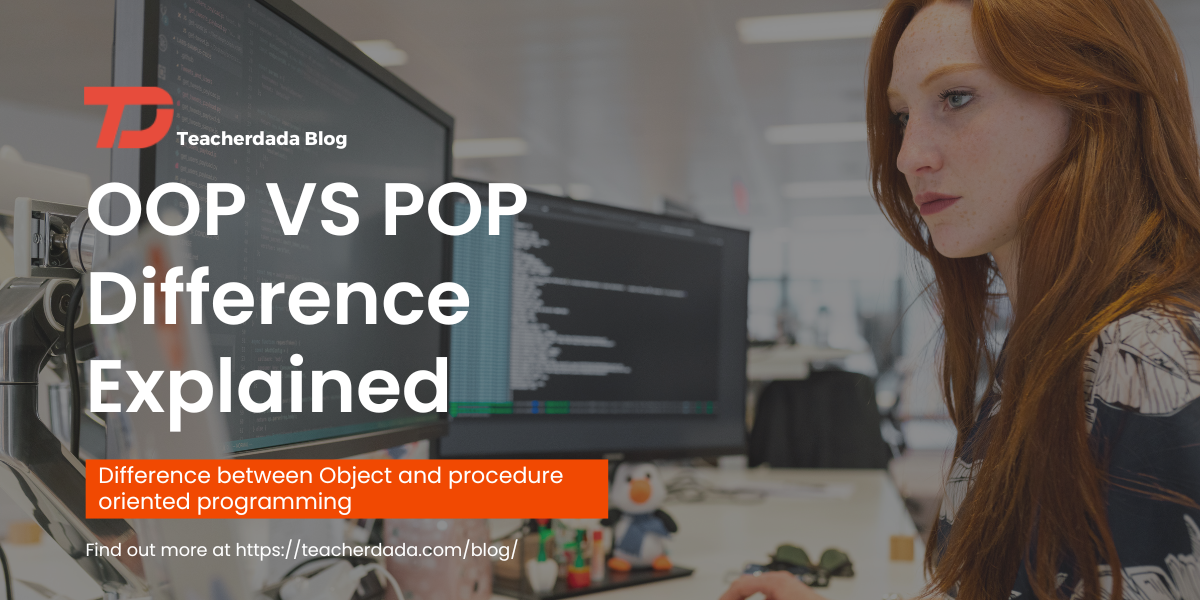As we know that all programming languages have a predefined mechanism to work with. These mechanisms are nothing but a set of structures and rules. These structures are known as Programming Paradigms. It’s not necessary that all structures are built on the same patterns. This is where the difference between OOP and POP comes in. Both concepts define the methods through which programming languages work. OOP refers to “Object-Oriented Programming” and POP refers to “ Procedure Oriented Programming”. These high-level programming languages solve problems with different methodologies. Check out our programming courses to skyrocket your skills.
The underlying feature that differentiates OOP from POP is that OOP works on object-based programs whereas POP works on programs that are divided into functions. According to the nature of the problem, programmers use these programming languages. There are a plethora of programming languages that work on machine code. It is the official language of computers as we know they won’t understand us in layman’s terms.

| OOP | POP |
|---|---|
| Object-oriented programming | Procedure/ Structure Oriented |
| Task done through procedure or structure | Objects are made that inherit the properties of a class. |
| Program is divided into sections called functions | Program is divided into sections called objects |
| No entity accessing mode | Entity accessing is categorized into public and private |
| No provision of Inheritance | Inheritance is present in three forms including public, private, and protected |
| Data is insecure | Data security through three modes including public, private, and protected. |
OOP vs POP: Difference
OOP Definition and Characteristics
Definition:
OOP is one of the high-level programming languages that work on object-oriented systems. Basically, the program is divided into objects that can make real-world scenarios. An object derives its features from a class where the attributes rea put by the programmer and further can be inherited to further classes. So you do not have to work from scratch for every class.
Languages: C++, Java, Python
Concepts of OOPS
There are two major concepts involved in OOPs that are objects and classes.
- Objects:
An object can be defined as anything we have in the real world including a human, bottle, chair, or any other object. In a computer programming language, these objects entail features from classes.
- Classes:
A class simply entails the properties of an object linked to it. In OOPS, there are mainly two components that are attributes and functions. Attributes define the properties and functions define objects.
- Abstraction:
Abstraction is the process of having properties in classes without showing intricate details. It just shows the functionality. It shows what it entails instead of how the properties are functioning. Abstraction helps in gathering details that further help in creating reusable codes.
One simple example could be how fingerprint works in mobile phones. The fingerprint unlocks the phone without having to understand how it functions. The same way the ATMs or starting an engine works.
- Inheritance:
In OOPs, Inheritance is the process of inheriting properties from an existing class or object. It enhances code reusability as you do not have to make codes from scratch. Under OOPs, there are multiple types of Inheritance including
- Single
- Hybrid
- Multiple
- Hierarchical
- Multi-Level
One fine example could be how smartphones like Nokia and Apple have inherited the properties of old classic phones.
- Encapsulation:
One of the best features of object-oriented programming is encapsulation which is the process where data is secured and binds all the attributes. It encapsulates all the data and restricts access. It regulates the maintainability, readability, and flexibility of the code.
- Polymorphism:
The properties are kept in multiple forms under polymorphism in OOPs. Polymorphism’ true value lies in sharing behaviors, so you do not have to make code from scratch. It refers to having the same object but different attributes or functionalities.
Advantages and Disadvantages of OOPs
| Advantages | Disadvantages |
| Maintenance of code | Large program size |
| Secured and Restricted Data | Require a lot of work |
| Re-usability and avoids writing from scratch | Speed is notoriously slow |
| Redundancy of Data | Learning OOPs take time |
| Benefits of Design that eliminates risks and enhances performance | OOP is challenging and cannot be used everywhere |
| the lower cost of development | OOP is considered as an object and have to comprehend carefully to implement them correctly. |
POP Definition and Characteristics
Definition:
POP works on functions that are broken down into a collection of routines. These routines work on a set of instructions in a systematic manner. The whole program is divided into segments called functions that work on a series of computational steps.
It works on procedures that comprehensively solve a problem from a top-down approach. The process starts with segments called functions with their own distinctive features that further work in the whole procedure. Procedural programming as the name suggests works on procedures that works on functions. In order to complete a task, the functions are written.
All programming languages work on instructions. In order to make procedural programming work, we instill a set of instructions that different further help in accomplishing tasks. As the functions are public, they are not more secure.
Some examples of POP (procedure-oriented programming) are COBOL, FORTRAN, PASCAL, C programming language, etc.
Advantages and Disadvantages of POP
| Easy programming without carefully constructing objects or classes | Data is exposed to the entire software |
| Ability to grasp | Real-world objects are difficult to relate to |
| Simplified structure | Versatility is limited |
| Functions can change anytime | Operation of data is given more weight |
| Uses the top-down approach | Limit the use of procedural programming |
| Functions share global data | Inability to reuse code |
| Memory need is reduced | Difficult in error checking |
Detailed Difference Between OOP and POP
Lets look at the differential factors in OOP VS POP.
| OOP | POP |
| OOP is object-oriented | POP works on structures and functions |
| The program works on objects and classes | The program works on functions that help in structuring |
| the Bottom-up approach | and Top-down approach |
| Data is controlled on its own | Every set of data is different so there is no control |
| New functions and data can be added | Adding data is difficult |
| Inheritance exists in three different modes | Inheritance doesn’t support |
| Data is hidden using encapsulation | Data can be accessed |
| Solves big problems | Not suitable for solving big issues |
| Examples are C++, JAVA, VB.NET, C#.NET | Examples are C, VB, FORTRAN, Pascal |
Wrapping Up
These two high-level programming paradigms are certainly very useful for different purposes. OOP has an edge over POP as it has evolved as a rather new concept. We hope our blog on OOP vs POP cleared your doubts about both programming paradigms. But if you are looking for comprehensive classes on programming languages that too in your regional languages, visit TeacherDada today and get affordable courses from certified teachers.

